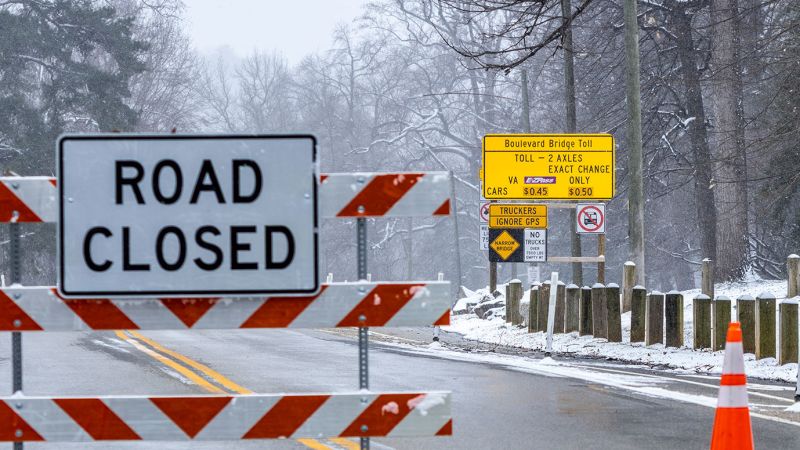In early April, President Donald Trump made the decision to release significant financial assistance through the Federal Emergency Management Agency (FEMA) for the state of Virginia, which was grappling with the aftermath of severe winter storms and flooding. Virginia Governor Glenn Youngkin, representing the Republican party, publicly hailed this decision, issuing a press release that highlighted the president’s approval of his disaster declaration request. This led to a wave of local media reporting which suggested that funding would soon be available for the state to address the pressing needs arising from the recent natural disasters.
However, a critical aspect of this disaster relief initiative met a roadblock: FEMA itself had not been informed of these developments. Officials within FEMA expressed to CNN that they were taken by surprise when they saw the news coverage announcing assistance. They indicated that such notifications typically come directly from the White House. The federal emergency response agency did not receive official communication about the funding until at least four days later, creating an alarming delay in an otherwise urgent process. This breakdown in communication meant that the already beleaguered communities in Virginia lost an additional week or so waiting for the crucial assistance they needed.
The incident has been described as part of a broader, unsettling trend observed during Trump’s second term. Current and former officials at FEMA have voiced several concerns regarding the administration’s management of disaster response, especially as meteorologists monitor storm patterns at the onset of hurricane season. In standard operational protocols under previous administrations, including Trump’s first term, FEMA would typically provide guidance to the White House on which disaster situations warranted federal aid. Following this, the president would approve or deny assistance, after which FEMA was promptly notified to begin relief operations. The agency traditionally reached out to state officials with updates about the aid.
Yet, during Trump’s second term, disruptions in communication and a lack of coordination between the White House and FEMA leadership have surfaced. This has resulted in confusion and delays, hampering the efforts of federal emergency managers striving to deliver assistance to states in need. A long-time FEMA official, who spoke on the condition of anonymity, indicated the complications were more than procedural. They noted that there are regulatory timelines, particularly for individual assistance programs, that must be adhered to, and delays affect the promptness of assistance.
In a related significant development in April, President Trump denied a request from Arkansas for disaster aid following severe tornadoes and storms that resulted in over 40 fatalities. Arkansas’s Republican Governor, Sarah Huckabee Sanders, who previously served as Trump’s press secretary, made concerted efforts to appeal for re-evaluation of the decision. Expressing her concerns directly to Trump, her lobbying eventually paid off, and on May 8, aid was approved through FEMA. Yet, like before, there was no immediate communication to the agency about this approval, leaving FEMA in the dark five days later until they were finally informed.
Such delays are perceived as unprecedented by FEMA officials, affecting their ability to act in a timely manner. They noted that an unexpected five-day lag in communication leads to questions regarding the agency’s efficiency. There have been additional instances where the White House had communicated with governors of various states prior to FEMA being notified of approved assistance. A spokesperson from the Department of Homeland Security (DHS) responded to inquiries from CNN by refraining from discussing the noted delays, asserting that disaster aid was being granted based on established policy rather than political considerations.
As the hurricane season commenced, concerns escalated among FEMA officials regarding preparedness and the effectiveness of the agency under the Trump administration’s current management. They expressed alarm over the absence of a clear strategy determining which disasters would qualify for federal support. The White House has emphasized that the president retains the sole discretion to approve or deny disaster declarations without necessitating justification, diverging from traditional protocols that relied heavily on FEMA’s assessments of damage and need.
During efforts to adapt and respond to several recent disasters, the administration’s lack of clarity on thresholds for federal assistance, combined with discussions of more stringent measures to qualify for aid, have left FEMA officials uneasy about their role in disaster response. Federal disaster declarations have consistently increased, reinforcing the necessity for a structured and effective response to increasingly destructive natural calamities resulting from climate change.
With news of essential personnel departures from FEMA and low morale among staff, the agency faces a challenging environment as it approaches a critical testing period. Recent communications among FEMA leadership reveal apprehension about the agency’s abilities and staffing levels amidst forecasts of an above-average hurricane season. With contrasting statements from DHS-enhanced officials and discontent among workers, concerns mount regarding FEMA’s capacity to fulfill its mission effectively.
As the uncertainty surrounding FEMA’s operational protocols and overall mission persists, affected communities can only hope that the agency will navigate through these complexities, ensuring timely support where needed most, all while grappling with the challenges posed by both internal and external pressures.



